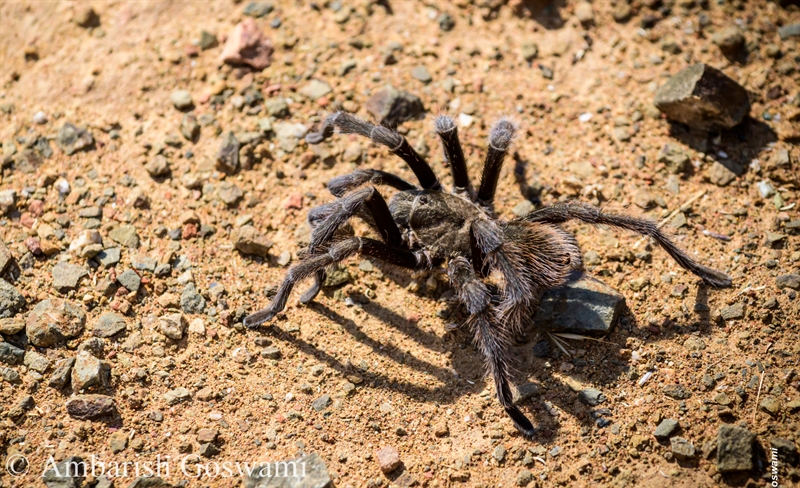
California Ebony Tarantula (Aphonopelma eutylenum). Photo by A. Goswami.
English poet, Alfred Lord Tennyson, in his 1842 poem Locksly Hall, wrote:
In the Spring a young man’s fancy lightly turns to thoughts of love.
– Alfred Lord Tennyson
For humans, Spring is the time for love. But for many animals, that season is Autumn. I’ve written before about how the behavior of deer changes in Autumn. For deer and many other animals it’s mating season. Babies are carried by their mothers through the lean winter months to be born in Spring, a time of relative abundance. This timing, synchronized to Earth’s orbit around the sun, gives their young the best chance to survive.
Tarantula Time
I’m hiking in an open-space preserve recently and bump into a hiker who recognizes me from the trips I lead for the US Fish and Wildlife Service. We walk a while until we came upon a large tarantula. I suspect it’s a California Ebony Tarantula (Aphonopelma eutylenum).
This is undoubtedly a male. Tarantulas usually remain in their underground lairs and only emerge to attack prey that wanders near. But during mating season males emerge from their dens to search for a mate. The male is between 8 – 12 years of age before it leaves its burrow. It will spend all of its energy looking for a partner and die of exhaustion just 6 months after reaching adulthood. Females can live to 25 years of age.
Its Hair is Worse Than it’s Bite
Tarantulas are large spiders. Females are larger than males and can reach 5 inches (13 cm) in diameter. That is a big spider! Even the males are impressive. And I’m usually shocked to see one walking along the trail.
Because of their large fangs, a tarantula bite can be painful. But tarantula venom does not pose a danger to humans. They do have spiky hairs on the abdomen that they can shed as a defense mechanism. These hairs can cause skin irritation.
But unlike Calisoga, tarantulas are non-aggressive and are unlikely to bite.
On we go
My fellow hiker snaps a photo of the amazing creature and then we leave it to continue its journey.
Are there animals that you only see certain times of year? Tell me about them in the comments below.
Related articles on NatureOutside
For fun facts and useful tips, join the free Bushcraft Newsletter.



Oh, thank God! It’s a good thing you reassured us that tarantulas release non-dangerous venom. One of my nieces has this crazy idea of finding such insects and making them her pet. Whatever, all she has to do now is talk to a breeder to make further arrangements.
Hi Sam! A tarantula bite is unlikely to kill a healthy adult human. But the bite is painful. And although the venom of tarantulas found in the United States is not considered dangerous, it may cause allergic reactions. The spiders’ hairs have barbs that can pierce human skin. This causes causing swollen, itchy bumps to form. Itching may last for weeks.
Please have your niece do her research and weigh the risks appropriately. Since I am neither a tarantula expert nor a medical doctor, you should always do your own research to verify the information for yourself.